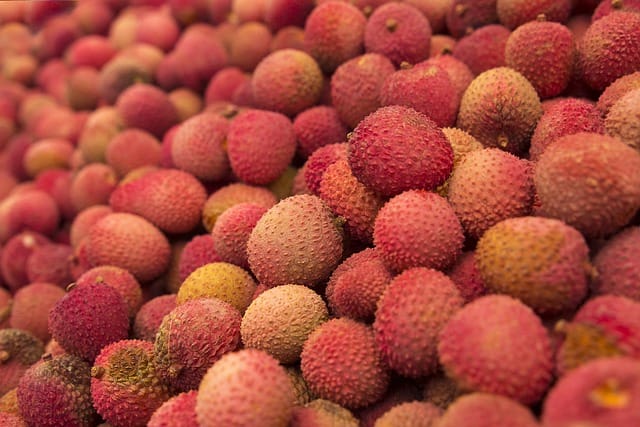How to grow Lychees
Lychees are delicious and tropical fruits that are highly sought after for their unique flavor and juicy texture

In this article:
- Introduction
- History and Origin of Lychees
- Types and Varieties of Lychees
- Climate and Soil Requirements
- Propagation and Planting
- Pruning and Training
- Watering and Fertilizing
- Managing Pests and Diseases
- Harvesting and Storage
- Common Challenges and Troubleshooting
- Popular Culinary Uses of Lychees
- Health Benefits of Lychees
- Interesting Facts and Trivia about Lychees
- Conclusion
Introduction
Lychees are delicious and tropical fruits that are highly sought after for their unique flavor and juicy texture. Growing lychees can be a rewarding experience, but it requires proper knowledge and care. In this article, we will guide you through the process of cultivating and nurturing lychee trees to ensure a successful harvest.
History and Origin of Lychees
Lychees have a rich history and are believed to have originated in China over 2,000 years ago. They were highly regarded by Emperors and were often presented as a tribute to them. From China, the cultivation of lychees spread to other parts of Asia and eventually reached countries like India, Thailand, and the United States.
Types and Varieties of Lychees
There are several different types and varieties of lychees available, each with its unique characteristics and flavor profiles. Some popular varieties include Emperor, Mauritius, and Brewster. It is essential to choose a variety that is suitable for your climate and intended use.
Climate and Soil Requirements
Lychees thrive in warm and subtropical climates. They require a minimum average temperature of 65°F (18°C) and cannot withstand frost. The soil should be well-draining, slightly acidic, and rich in organic matter. Avoid waterlogged or compacted soil as it can hinder the growth and development of the lychee tree.
Propagation and Planting
Lychees can be propagated through seeds, cuttings, or grafting. However, for desired characteristics and a shorter time to fruiting, it is recommended to plant grafted nursery trees. Choose a healthy nursery tree and plant it in a prepared hole, making sure that the graft union remains above the soil surface.
Pruning and Training
Pruning and training the lychee tree are essential to promote proper growth and shape as well as to improve airflow and light penetration. Remove any dead or damaged branches and conduct annual pruning to maintain a desirable size and shape. Proper training can also help support the weight of the fruit clusters.
Watering and Fertilizing
Lychees require regular watering, especially during dry periods. Young trees should be watered frequently, while established trees can be watered deeply but less frequently. Avoid overwatering to prevent root rot. Additionally, regular fertilization with a balanced fertilizer can provide the necessary nutrients for optimal growth and fruit production.
Managing Pests and Diseases
Lychees are susceptible to certain pests and diseases, such as fruit flies, scale insects, and anthracnose. Regular monitoring of the tree, proper sanitation, and the use of organic pest control methods can help manage these issues. Consult with a local agricultural extension office or a horticulture expert for specific pest and disease management recommendations in your area.
Harvesting and Storage
Lychees are usually ready for harvest when the skin turns bright red or pink. Carefully pluck the fruit from the tree, taking care not to damage them. Lychees are highly perishable and should be consumed or stored in the refrigerator within a few days of harvesting. To extend their shelf life, you can freeze lychees by removing the skin and seeds before placing them in an airtight container.
Common Challenges and Troubleshooting
While growing lychees can be a rewarding experience, there may be some challenges along the way. Common issues include leaf discoloration, fruit drop, or poor fruit set. These problems can be caused by various factors, including nutrient deficiencies, improper watering, or pest infestations. Identifying and addressing these issues promptly is crucial for optimal tree health and fruit production.
Popular Culinary Uses of Lychees
Lychees are not only delicious when eaten fresh, but they can also be used in various culinary preparations. They are commonly used in desserts, fruit salads, cocktails, and even savory dishes. The sweet and tangy flavor of lychees adds a refreshing twist to many recipes.
Health Benefits of Lychees
Lychees are not only delectable but also offer several health benefits. They are a great source of vitamin C, antioxidants, and dietary fiber. Consuming lychees may help boost the immune system, improve digestion, and promote healthy skin.
Interesting Facts and Trivia about Lychees
Here are some intriguing facts and trivia about lychees:
- Lychee trees can reach heights of up to 40 feet (12 meters).
- The lychee fruit is a symbol of romance and love in Chinese culture.
- Lychees belong to the soapberry family.
Conclusion
Growing lychees can be a gratifying endeavor for any fruit enthusiast. By following the proper techniques and caring for your lychee tree diligently, you can enjoy a bountiful harvest of this delightful fruit. Remember to address any challenges promptly and explore the various culinary possibilities that lychees offer. Happy growing!
